
The ginataang bilo-bilo is a classic Filipino kakanin. It’s called different names depending on where you live. The Tagalogs mostly call it as it is while the Kapampangans refer to it as tambu-tambong. If you’re from Pangasinan like me, we call it, Kiniler [kee-knee-lur]. It’s mostly eaten as a snack but you can surely have it as comfort food during the rainy season.
Essentially, this delicacy is like a hot version of the well-known Pinoy merienda, Halo-Halo. The only differences between these two are the presence of the bilo-bilo or the glutinous flour balls and how they are prepared.
Table of Contents
Ginataang Bilo-bilo ingredients
I think the best part about making bilo-bilo or kiniler is that you can add whatever ingredient you like. For example, some people add in ube yam cubes or corn kernels. Others even add spices such as anise. In this recipe, my mom used the following:
- Kamoteng Kahoy – Which in English, they call Cassava. Here in my town, you can readily source them from the local market. When you buy kamoteng kahoy, you should try pinching its skin. You can tell that it’s a good cassava if the peel readily comes off when you pinch it.
- Langka – I absolutely love the taste, scent, and texture of Lanka or jackfruit. It’s a popular fruit added to desserts such as the kiniler or Halo-halo.

- Kamote – Kamote or sweet potato is widely available in the province. You can buy them at around 30 to 40 pesos per kilo. In this recipe you need roughly about 250 grams. If you want your ginataang bilo-bilo to look colorful, you can use different variants of kamote. There’s the purple, white, and orange type.
- Tapioca pearls – You can easily find cooked tapioca pearls in market stalls that sell ingredients for Halo-halo. If food presentation matters a lot to you, you can buy ones that come in assorted colors.

- Pandan – Boiling pandan leaves in coconut milk gives that sweet and delectable scent. It’s common for many folks to use pandan leaves when they make kakanins.
- Gata – Living in the province allows us to get access to fresh local produce such as coconuts. Hence, when we make filipino kakanin, we don’t really resort to the powdered coconut milk. Vendors sell both the kakang gata and the diluted coco milk.
- Saba – Plantains are commonly used in making Pinoy desserts such as sweet banana, banana cue, and halo-halo. For this recipe, you don’t need to do anything special to the banana. Just slice it to about 1/4 inch thick so it can cook quickly.
Glutinous flour used in making bilo-bilo

Glutinous rice is the core of every Pinoy kakanin. They use it in making suman, butchi, and biko. And in this recipe, its flour form, galapong was used to make the bilo-bilo balls. Now traditionally, locals make galapong by soaking the glutinous rice for around three to four hours. Then they have it milled in local “gilingans” to obtain the powdered form. In our case, we opted to use store-bought glutinous rice flour.

The secret ingredients

Besides the ingredients above, my mom also adds two more ingredients – Nestle All Purpose Cream and a pinch of salt. Adding the All-Purpose cream adds more creaminess to the dish. The pinch of salt, on one hand, balances all the sweetness and creaminess of all the ingredients.
Ready to cook this uber-yummy Filipino treat? Check out the recipe below.
Creamy Ginataang Bilo-bilo
Ingredients
- 350 mL coconut milk Kakang gata or first-press
- 350 mL Coconut milk (ikalawang piga) second-press
- 1 cup Tapioca pearls cooked
- 2 cups Cassava cubed
- 2 cups Sweet potato cubed
- 2 cups Saba banana sliced
- 1 cup Jackfruit strips
- 2 pieces Pandan leaves
- 220 mL Nestle All-Purpose Cream
Glutinous rice balls
- 220 grams Galapong or glutinous rice flour
- 1 cup water
Thickener
- 3 tbsp Glutinous rice flour
- 4 tbsp water
Instructions
Making the glutinous rice ball
- In a bowl, mix the glutinous rice flour with water. Add the water gradually while mixing. Once the mixture starts to come together, you can proceed to knead the dough.

- Start making thin rolls out of the dough. It should be roughly about 2 cm wide so that when you start chopping them, you can create small-sized circles. Feel free to roll around the small pieces of dough on your palm to create uniform shapes. Then, place these tiny balls on a plate dusted with glutinous flour.

Cooking the bilo-bilo
- In a large saucepan, pour the second press coconut milk and let it boil. Once the coconut milk reaches boiling point, you can turn down the heat and start adding the ingredients.

- Start with the cubed cassava first. Add it to the mixture and leave it to cook for 20 to 25 minutes.

- Then, add the sweet potato cubes, pandan leaves, and jackfruit. Let these cook for 10 minutes. Start tasting and add sugar gradually. Feel free to adjust the sugar content, depending on your taste preference. You should also add a pinch of salt to bring out the taste of the ingredients.
- Throw in the bananas. Allow these to cook until the color changes to pale yellow.
- Start adding the bilo-bilo or glutinous rice balls. Let them cook until they float on the mixture.

- Add the tapioca pearls, first-press coconut milk, and Nestle All-Purpose cream. Simmer for 5 minutes.
- Serve while hot or refrigerate overnight before serving.


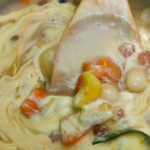
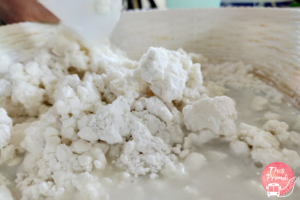
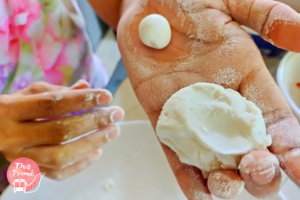

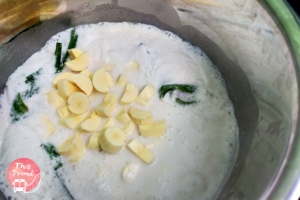
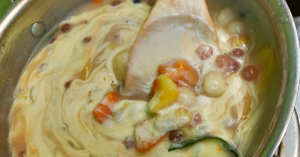
No Comment